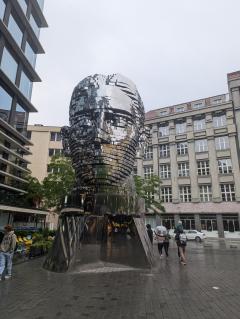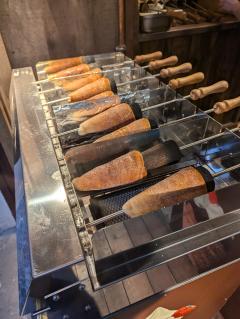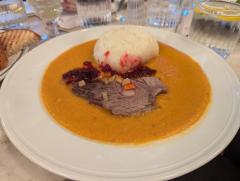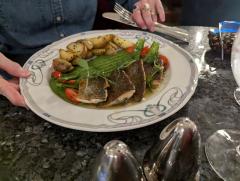 About 10 years ago I was lucky to have a Czech colleague and friend named Jana. We had a kitchen in that office and she showed me how to make some Czech dishes, especially my favorite, a sort of pot roast called svíčková na smetaně. Jana is back in Prague now, so I contacted her for this trip. She joined us on the second day for a drive into the Czech countryside.
About 10 years ago I was lucky to have a Czech colleague and friend named Jana. We had a kitchen in that office and she showed me how to make some Czech dishes, especially my favorite, a sort of pot roast called svíčková na smetaně. Jana is back in Prague now, so I contacted her for this trip. She joined us on the second day for a drive into the Czech countryside.
We were incredibly lucky to have her with us, as you'll read here, and of course because I cannot read Czech road signs!
The first order of business was to get a rental car for the day from Avis. As with everything else while travelling abroad, there were unexpected complications that Jana resolved quickly. Our goal for the day was to visit the Glass & Jewelry Museum in Jablonec nad Nisou, then to proceed on to Josefův Důl, Czechia to visit the workshop and studio of glass artist Jan Pesnicak. By amazing coincidence, Jana's parents and Pesnicak live in the same village!
 Jablonec nad Nisou is about an hour and a quarter northeast of Prague, near the Polish border, in an area known for the famous Bohemian glassworkers. We got there without incident. The drive was pleasant once we got out of the city, plenty of flat farm country with the occasional factory seemingly dropped from the sky right in the middle of the fields. Eventually we approached the satisfyingly-named Giant Mountains. Of course, we might have been hopelessly lost without Jana to read the signs!
Jablonec nad Nisou is about an hour and a quarter northeast of Prague, near the Polish border, in an area known for the famous Bohemian glassworkers. We got there without incident. The drive was pleasant once we got out of the city, plenty of flat farm country with the occasional factory seemingly dropped from the sky right in the middle of the fields. Eventually we approached the satisfyingly-named Giant Mountains. Of course, we might have been hopelessly lost without Jana to read the signs!
We parked in a municipal lot in the middle of town, and stopped at the Story Cafe where the women had some sweet things and I had their house special Cafe Story with salted caramel in bottom. The most interesting thing was Lorna's Meadow Cake, which was green from spinach juice (we couldn't taste the spinach, it was a lovely cake) with a white mascarpone filling.
 The Glass & Jewelry Museum is in two sections, a lower floor about glass manufacture and trade in Bohemia, and an upper floor with jewelry. There's also a new glass wing with new art glass. I was particularly interested in the information about the manufacture and transport of "stones", tiny glass beads used in the manufacture of costume jewelry for the stage. These were made in all the traditional shapes of fancy-cut gemstones and many more shapes and in brilliant colors, and displayed both as base products for trade and in elaborate jewelry from operas and the dramatic stage in the 18th and 19th centuries.
The Glass & Jewelry Museum is in two sections, a lower floor about glass manufacture and trade in Bohemia, and an upper floor with jewelry. There's also a new glass wing with new art glass. I was particularly interested in the information about the manufacture and transport of "stones", tiny glass beads used in the manufacture of costume jewelry for the stage. These were made in all the traditional shapes of fancy-cut gemstones and many more shapes and in brilliant colors, and displayed both as base products for trade and in elaborate jewelry from operas and the dramatic stage in the 18th and 19th centuries.
 Josefův Důl is a tiny place with fewer than 900 inhabitants. We met Jana’s parents at their home, the pretty B&B Pension Alpa Skrivanova, and they had prepared a traditional Czech lunch for us! We started with toasted bread served with fresh garlic cloves to be crushed and spread on the toast. Then there were apricot dumplings for Lorna & Melissa, and
Josefův Důl is a tiny place with fewer than 900 inhabitants. We met Jana’s parents at their home, the pretty B&B Pension Alpa Skrivanova, and they had prepared a traditional Czech lunch for us! We started with toasted bread served with fresh garlic cloves to be crushed and spread on the toast. Then there were apricot dumplings for Lorna & Melissa, and
Freelinking: Unknown plugin indicator
with dumplings for the rest of us. We finished up with blueberry cake from their local blueberries. Lorna and Melissa got a tour of the B&B while Jana's mom and I had an in-depth discussion of tips and tricks for making svickova, and her dad, a musician, played the piano.
 After lunch we went to the Pesnicak studio, where we got a personal tour from the artist and we bought 9 items! This was a primary focus of the whole vacation for Lorna, who had wanted to get here for years. Pesnicak makes many different items in glass, but Lorna is particularly fond of his Art Nouveau perfume bottles, especially the work he does in bright yellow-green vaseline glass, known in Czechia as uranium glass. There is indeed uranium in the glass to give it that color (and it glows weird green under black light), but it is not radioactive so it's perfectly safe as a consumer product. That's good, because she has a full cabinet of vaseline glass at home in Plymouth!
After lunch we went to the Pesnicak studio, where we got a personal tour from the artist and we bought 9 items! This was a primary focus of the whole vacation for Lorna, who had wanted to get here for years. Pesnicak makes many different items in glass, but Lorna is particularly fond of his Art Nouveau perfume bottles, especially the work he does in bright yellow-green vaseline glass, known in Czechia as uranium glass. There is indeed uranium in the glass to give it that color (and it glows weird green under black light), but it is not radioactive so it's perfectly safe as a consumer product. That's good, because she has a full cabinet of vaseline glass at home in Plymouth!
 After the glass studio we returned to Prague, where we had a date to meet Jana's boyfriend Filip at a Tim Burton exhibit and then some more exploring and dinner at a famous restaurant. The drive back was uneventful - in my opinion driving in Prague is no more stressful than driving in Boston, as long as you know what the traffic signs say. We returned the car and too a taxi back to the hotel.
After the glass studio we returned to Prague, where we had a date to meet Jana's boyfriend Filip at a Tim Burton exhibit and then some more exploring and dinner at a famous restaurant. The drive back was uneventful - in my opinion driving in Prague is no more stressful than driving in Boston, as long as you know what the traffic signs say. We returned the car and too a taxi back to the hotel.
The Tim Burton exhibit was conveniently less than a block from the hotel. It was really interesting, and it kicked off what would become a long, in-depth study of art from the current day back in time through the Renaissance and Roman times to ancient Greece!
 After the exhibit we commenced the long guided tour as we walked to the Cafe Slavia. It was about a mile, but it was full of historical sites, interesting shops, and awesome architecture. Filip was great about pointing out some of the key sites in the Velvet Revolution of 1989, when half a million people filled the streets and squares in non-violent protest to demand the end of the Communist government. It worked, and the following month the poet and playwright Vaclav Havel was elected President.
After the exhibit we commenced the long guided tour as we walked to the Cafe Slavia. It was about a mile, but it was full of historical sites, interesting shops, and awesome architecture. Filip was great about pointing out some of the key sites in the Velvet Revolution of 1989, when half a million people filled the streets and squares in non-violent protest to demand the end of the Communist government. It worked, and the following month the poet and playwright Vaclav Havel was elected President.
Along the way we passed a really cool sculpture: the giant rotating head of Franz Kafka! It's constructed of many horizontal plates, and every hour it turns 90 degrees to its left, starting from the chin, and then turning back starting from the top of the head. Kafka worked as a clerk in a nearby building, but he gained fame as a writer of surreal fiction that illuminates the frustrations of daily struggles with bureaucracy and the legal system.
 During the walk I noticed that in the Old Town, every street had fine sidewalks of black and white paving stones, but each street seemed to have its own unique pattern. There was also almost no litter and the public trash cans were never overflowing, as is so often the case here.
During the walk I noticed that in the Old Town, every street had fine sidewalks of black and white paving stones, but each street seemed to have its own unique pattern. There was also almost no litter and the public trash cans were never overflowing, as is so often the case here.
I did make a foodie discovery along the way! There were numerous pushcarts and stalls selling Trdelnik, or Czech Chimney Cakes. A chimney cake is a strip of thick cake batter wrapped around a stick and baked over hot coals or a propane stove. When the cake is baked, it is slid off the stick and served either as is or often filled with something sweet. Here is a row of Trdelniky at such a vendor, the two nearest ones are staying warm waiting for a customer, and then the rest are baking. You can see the wooden handles that the vendor uses to manually turn them for even baking.
This street treat is known in neighboring Hungary as a spit cake, a name that I do not find appealing!
 We eventually made it to Slavia Cafe for dinner. It's a grand old place overlooking the river, with the castle looking down from the other side. It is historic, having opened almost 150 years ago and having served princes and presidents; Vaclav Havel was a regular there.
We eventually made it to Slavia Cafe for dinner. It's a grand old place overlooking the river, with the castle looking down from the other side. It is historic, having opened almost 150 years ago and having served princes and presidents; Vaclav Havel was a regular there.
On one wall near us was a large painting of an absinthe drinker being visited by the Green Fairy, the symbol of that infamous drink's mythical mind-altering properties. Absinthe is now known to be no more harmful than other liquor and there's an active absinthe culture in Prague cafes. Slavia has a few absinthes on the menu, including some Czech ones, and they have a pretty absinthe fountain, so Melissa and I started with a Czech Absinthe while Jana had a Raspberry Ale for Jana, and Filip had a Bud (a Budvar Budweiser, the original Budweiser).
 For dinner, Filip and I both got the Svickova. I had had Svickova for lunch with Jana's parents, but this particular dish, an icon of Czech cuisine, has become a quest for me to understand the ways of Czech cooking. For example, the white blob in the back is not potatoes but Knedlik, an obligatory Czech bread dumpling that accompanies many meals and is as important to your credentials as a cook as Thanksgiving gravy is in the US. If you look closely under the bit of carrot there's a white spot in the meat; that's a bit of porkfat that was used to lard the beef, a tough cut that is little-used here but that is traditional for the Svickova. To lard beef you need the fat and a larding needle. The sauce needs the right consistency. These are the things that I was finally experiencing personally to back up by book-learning. I'll update the svíčková na smetaně recipe the next time I make it with the things that I learned on this day.
For dinner, Filip and I both got the Svickova. I had had Svickova for lunch with Jana's parents, but this particular dish, an icon of Czech cuisine, has become a quest for me to understand the ways of Czech cooking. For example, the white blob in the back is not potatoes but Knedlik, an obligatory Czech bread dumpling that accompanies many meals and is as important to your credentials as a cook as Thanksgiving gravy is in the US. If you look closely under the bit of carrot there's a white spot in the meat; that's a bit of porkfat that was used to lard the beef, a tough cut that is little-used here but that is traditional for the Svickova. To lard beef you need the fat and a larding needle. The sauce needs the right consistency. These are the things that I was finally experiencing personally to back up by book-learning. I'll update the svíčková na smetaně recipe the next time I make it with the things that I learned on this day.
 Jana got the Wienerschnitzel, which is as popular in Czechia as it is in its Austrian homeland. (Another popular immigrant is Gulas, or Hungarian Goulash.) Melissa, a vegetarian, ordered two small plates: a cheese assortment from a local farm and a plate of herb pancakes on whipped cheese with grilled seasonal vegetables, pea and carrot chips, roasted seeds, and basil pesto.
Jana got the Wienerschnitzel, which is as popular in Czechia as it is in its Austrian homeland. (Another popular immigrant is Gulas, or Hungarian Goulash.) Melissa, a vegetarian, ordered two small plates: a cheese assortment from a local farm and a plate of herb pancakes on whipped cheese with grilled seasonal vegetables, pea and carrot chips, roasted seeds, and basil pesto.
Lorna was less lucky. Prague is far from the sea and the only fish on the menu was farmed Zander fish. Zander is a bland white freshwater fish that's popular in Eastern Europe. It was underdone and when it came back well-done she didn’t like it anyway!
At the end of dinner we all agreed that we'd eaten enough that day and the best dessert would be a taxi back to the Hotel Paris!
